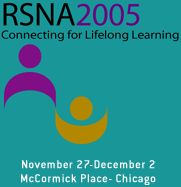
Abstract Archives of the RSNA, 2005
Francesco Sardanelli MD, Abstract Co-Author: Nothing to Disclose
Giacomo Papini MD, Abstract Co-Author: Nothing to Disclose
Biagio Cotticelli MD, Abstract Co-Author: Nothing to Disclose
Nicola Flor MD, Presenter: Nothing to Disclose
Gian Paolo Cornalba MD, Abstract Co-Author: Nothing to Disclose
To use electronic subtraction to detect carotid plaque enhancement in contrast-enhanced MR angiography.
Forty-six consecutive patients (35 males and 17 females, mean age 69.0 years) underwent bilateral carotid MR angiography using a coronal 3D sequence with
an automated bolus (2 mL/s; 12-15 s delay, care-bolus) of 0.1 mmol/kg of Gd-BOPTA (Bracco, Italy). Before and after this sequence a 3D fast low-angle shot T1-w. sequence (TR/TE=20/4.8 msec; flip angle 70 degrees; matrix 256x256; field of view 260 mm; 20 axial partitions of 3-mm thickness) was acquired on the carotid bifurcation with a 2-4 minutes delay after contrast injection. Electronic subtraction (unenhanced minus enhanced axial images) was performed. Internal carotid stenoses were graded on maximum intensity projections and multiplanar reformatted images obtained from the coronal acquisition according to NASCET: mild (0-29%); moderate (30-69%); severe (70-99%). Plaque enhancement was evaluated on axial images on a remote consolle (free magnification and windowing) by two radiologists using only unenhanced and enhanced images or only subtracted images, in separate sessions, by consensus. For each of the two sessions, a 4-point score for plaque enhancement was given, from 0 (no enhancement) to 3 (clear enhancement). Wilcoxon test was used.
On the total of 92 carotids, mild stenosis was found in 29 (32%), moderate in 39 (42%) and severe in 24 (26%). Plaque enhancement was detected in 8/46 patients (17%) and in 9/92 carotids (10%); stenosis degree of these cases was mild in 2/9 (22%), moderate in 6/9 (67%) and severe in 1/9 (11%). Using unenhanced and enhanced images, the plaque enhancement was visible in 7/9 (77%) with a mean score of 1.44±.88 while using subtracted images it was detected in 9/9 (100%) with a mean score of 2.44±.53 (P=.0277).
Electronic subtraction enabled us to detect carotid plaque enhancement better than visual inspection of unenhanced and enhanced images. Plaque enhancement does not seem to correlate with the stenosis degree. Further studies are warranted to define the relation of plaque enhancement with plaque histopathology, inflammatory status, and instability.
Sardanelli, F,
Papini, G,
Cotticelli, B,
Flor, N,
Cornalba, G,
Electronic Subtraction for Detecting Carotid Plaque Enhancement in Contrast-enhanced MR Angiography. Radiological Society of North America 2005 Scientific Assembly and Annual Meeting, November 27 - December 2, 2005 ,Chicago IL.
http://archive.rsna.org/2005/4408129.html

